Japanese Nambu Pistols
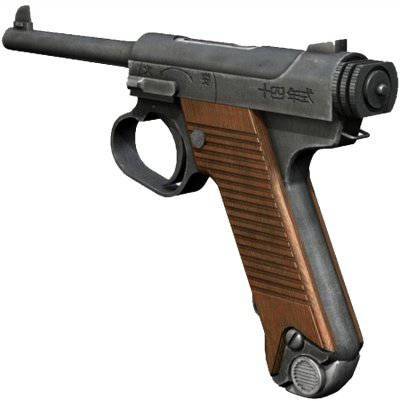 The pistol was designed by artillery captain Kijiro Nambu, whose biography from the modern point of view seems to be just wild. Being the son of a samurai who could barely make ends meet and could not afford the maintenance and upbringing of the child, Kijiro was sold to a local merchant. What now seems abnormal was quite common practice at the time. The merchant treated the new “son” as his own and prepared to replace him in the boy’s face. However, Kijiro did not forget who his biological father was and decided to devote his life to military affairs, which was also supported by his step-mother. In other words, Kijiro Nambu received the “green light” in all his endeavors, although he was not a child in the family of a merchant. It is not strange, but such an attitude towards the child did not spoil him, but on the contrary gave the fruits that every parent dreams of. At the age of 23, Kijiro graduated from the Military Imperial Academy with honors, while he was released from the academy already in the rank of lieutenant, which was rare even for the best graduates. Soon the lieutenant became the captain and was sent by the command to the Tokyo Arsenal. It should be noted here that Kijiro was thoroughly fed up with all of his rational suggestions, but they were really useful, however, no one likes it when he is told how to do better, especially when he is right. So the translation of Captain Kijiro can be considered as something that they simply wanted to get rid of, however, the person got the place where he could bring the maximum benefit, so everything is not so simple. The Tokyo Arsenal was the main center where artillery samples and samples of handguns were born at that time. The captain continued his stormy activities there and was soon noticed by the gunsmith Arisaka, known for his rifle and cartridge for this rifle, as well as other developments. Just at this time, the Tokyo Arsenal received a new task, which was to create a new pistol for the Japanese army, this task was assigned to implement Kijiro and he coped with it, but despite this, the weapon was not accepted for service. So the first version of the gun appeared.
The pistol was designed by artillery captain Kijiro Nambu, whose biography from the modern point of view seems to be just wild. Being the son of a samurai who could barely make ends meet and could not afford the maintenance and upbringing of the child, Kijiro was sold to a local merchant. What now seems abnormal was quite common practice at the time. The merchant treated the new “son” as his own and prepared to replace him in the boy’s face. However, Kijiro did not forget who his biological father was and decided to devote his life to military affairs, which was also supported by his step-mother. In other words, Kijiro Nambu received the “green light” in all his endeavors, although he was not a child in the family of a merchant. It is not strange, but such an attitude towards the child did not spoil him, but on the contrary gave the fruits that every parent dreams of. At the age of 23, Kijiro graduated from the Military Imperial Academy with honors, while he was released from the academy already in the rank of lieutenant, which was rare even for the best graduates. Soon the lieutenant became the captain and was sent by the command to the Tokyo Arsenal. It should be noted here that Kijiro was thoroughly fed up with all of his rational suggestions, but they were really useful, however, no one likes it when he is told how to do better, especially when he is right. So the translation of Captain Kijiro can be considered as something that they simply wanted to get rid of, however, the person got the place where he could bring the maximum benefit, so everything is not so simple. The Tokyo Arsenal was the main center where artillery samples and samples of handguns were born at that time. The captain continued his stormy activities there and was soon noticed by the gunsmith Arisaka, known for his rifle and cartridge for this rifle, as well as other developments. Just at this time, the Tokyo Arsenal received a new task, which was to create a new pistol for the Japanese army, this task was assigned to implement Kijiro and he coped with it, but despite this, the weapon was not accepted for service. So the first version of the gun appeared. This sample appeared in 1902 year, dubbed it then as Nambu A, but this name was taken outside the country, in Japan this gun was called, if translated literally, “Nambu Large Automatic Pistol”, and the gun really was not small. The weight of the weapon without ammunition was 870 grams, while the gun itself was a length of 229 millimeters with a barrel length of 114 millimeters. Of course, this is not so much in comparison with other samples of that time, but quite a lot with the condition of using not the most powerful cartridge that had to be created for the new weapon.
This sample appeared in 1902 year, dubbed it then as Nambu A, but this name was taken outside the country, in Japan this gun was called, if translated literally, “Nambu Large Automatic Pistol”, and the gun really was not small. The weight of the weapon without ammunition was 870 grams, while the gun itself was a length of 229 millimeters with a barrel length of 114 millimeters. Of course, this is not so much in comparison with other samples of that time, but quite a lot with the condition of using not the most powerful cartridge that had to be created for the new weapon.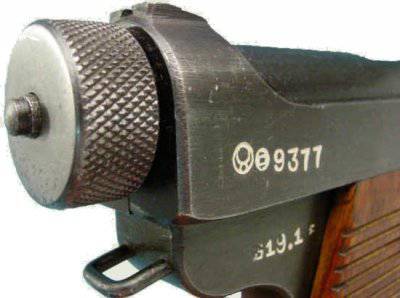 The new cartridge had the metric designation 8х22. An eight-millimeter bullet weighing 6,6 grams accelerated to a speed of 315 meters per second, a powder charge weighing 0,26 grams of smokeless powder. In addition, there were also variants of cartridges in which black powder was used, although the powder charge was increased to 0,4 grams, but despite this, the bullet speed was only 280 meters per second. Thus, it turns out that the kinetic energy of the bullet in the first version was about 328 Joules, and in the second about 260 Joules. The bullet cartridge was shell, but even, nevertheless, it completely gave all the energy to the target in the form of the human body, often without causing through wounds, which was definitely a plus. Separately, it should be noted that there were serious problems in storing the first batch of these cartridges, since the junction of the cartridge case and the bullet simply was not protected by anything.
The new cartridge had the metric designation 8х22. An eight-millimeter bullet weighing 6,6 grams accelerated to a speed of 315 meters per second, a powder charge weighing 0,26 grams of smokeless powder. In addition, there were also variants of cartridges in which black powder was used, although the powder charge was increased to 0,4 grams, but despite this, the bullet speed was only 280 meters per second. Thus, it turns out that the kinetic energy of the bullet in the first version was about 328 Joules, and in the second about 260 Joules. The bullet cartridge was shell, but even, nevertheless, it completely gave all the energy to the target in the form of the human body, often without causing through wounds, which was definitely a plus. Separately, it should be noted that there were serious problems in storing the first batch of these cartridges, since the junction of the cartridge case and the bullet simply was not protected by anything.The Nambu A pistol itself was very much reminiscent of the Parabellum silhouette, but apart from the distant external resemblance of the silhouette, he had nothing in common with this weapon. In general, the weapon was sharpened according to the scheme of automation with a short stroke of the barrel, however, this system of automation was implemented was not quite usual by modern measures. As such, the casing-bolt in the weapon was not and if you divide the gun into its component parts, it will be a pistol grip with a trigger mechanism, a barrel rigidly fixed in a mobile receiver, as well as a bolt that moves inside the receiver, protruding far back into its rearmost position. Locking the barrel of the weapon occurred when turning the locking latch, which connected the bolt of the weapon with the receiver, and accordingly the barrel.
 It all worked as follows. At rest, the bolt of the weapon was connected with a barrel larva with the barrel and the receiver of the pistol, that is, the movement of these parts separately was impossible. When fired, the powder gases sought to increase the distance between the bullet and the cartridge case, pushing one with the same force forward and the other back, exactly until the bullet left the barrel and the powder gases did not receive freedom. However, due to the large mass of the bolt and barrel with the receiver, this short-term impulse created by the powder gases was preserved and forced the entire upper part of the pistol to move backwards. Here we need to make a small digression and praise the originality of the arrangement of the return springs, since the receiver with the barrel had one return spring that connected the receiver and the frame of the weapon, and the shutter had two, located on both sides, which connected the shutter and receiver . It should be noted separately that the return spring of the receiver and the trunk was also a spring that caused the locking latch to rise. Thus, due to the effect of powder gases, the receiver and the bolt began to move backward, while only the return spring of the receiver began to contract. When the return spring of the receiver box was compressed, the locking latch was lowered under its own weight, as a result of which the receiver with the barrel and the bolt moved further back, but not bound by anything. Reaching his extreme rear position, the receiver and barrel changed their direction of movement under the action of the return spring, and the shutter continued to move backward, compressing its two return springs. When moving the receiver with the barrel forward and the bolt back, the spent cartridge case was removed from the chamber and thrown through the window in the upper part of the receiver. Having reached its extreme rear point, the valve changed its direction of movement, at that moment the receiver with the barrel was already in its normal position, and their return spring lifted the latch, which the valve slid forward as it moved forward, feeding the new cartridge into the chamber. Having reached its extreme front position, the bolt rested against the breech of the gun, and the latch entered the groove, preventing the bolt from moving separately from the barrel and the receiver.
It all worked as follows. At rest, the bolt of the weapon was connected with a barrel larva with the barrel and the receiver of the pistol, that is, the movement of these parts separately was impossible. When fired, the powder gases sought to increase the distance between the bullet and the cartridge case, pushing one with the same force forward and the other back, exactly until the bullet left the barrel and the powder gases did not receive freedom. However, due to the large mass of the bolt and barrel with the receiver, this short-term impulse created by the powder gases was preserved and forced the entire upper part of the pistol to move backwards. Here we need to make a small digression and praise the originality of the arrangement of the return springs, since the receiver with the barrel had one return spring that connected the receiver and the frame of the weapon, and the shutter had two, located on both sides, which connected the shutter and receiver . It should be noted separately that the return spring of the receiver and the trunk was also a spring that caused the locking latch to rise. Thus, due to the effect of powder gases, the receiver and the bolt began to move backward, while only the return spring of the receiver began to contract. When the return spring of the receiver box was compressed, the locking latch was lowered under its own weight, as a result of which the receiver with the barrel and the bolt moved further back, but not bound by anything. Reaching his extreme rear position, the receiver and barrel changed their direction of movement under the action of the return spring, and the shutter continued to move backward, compressing its two return springs. When moving the receiver with the barrel forward and the bolt back, the spent cartridge case was removed from the chamber and thrown through the window in the upper part of the receiver. Having reached its extreme rear point, the valve changed its direction of movement, at that moment the receiver with the barrel was already in its normal position, and their return spring lifted the latch, which the valve slid forward as it moved forward, feeding the new cartridge into the chamber. Having reached its extreme front position, the bolt rested against the breech of the gun, and the latch entered the groove, preventing the bolt from moving separately from the barrel and the receiver.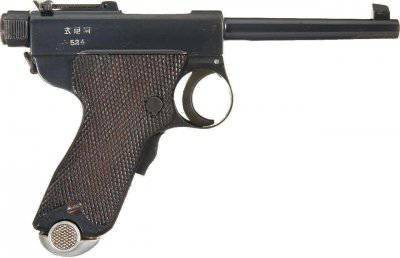 In order to put the weapon on alert, the shooter needed to take hold of the back of the bolt, which for convenience was cut with notches and pull over. In this case, everything happened just like when fired, but more slowly, after the bolt was drawn, it was enough to release it, while the new cartridge was fed, and the combat spring inside the bolt was compressed. To ensure the safety of carrying weapons and eliminate the possibility of accidental firing, the pistol had an automatic safety device that was a key on the handle similar to that of Browning pistols, but it was located not from the back of the pistol handle, but from the front, which was more convenient. matter of habit. This essentially key was in no way connected with the trigger mechanism of the weapon, but simply blocked the trigger in its normal position. Manual gun did not have a fuse. The gun was fed from a detachable box magazine with a single row arrangement of ammunition with a capacity of 8 cartridges. It is interesting that even then they thought about reducing the weight of the weapon, and the lower part of the pistol shop was made of aluminum, the truth of the gain in this maximum per gram of 30 was insignificant, but at that time something else was not solved. The sights of the pistol were open, consisted of a pillar and fly. The fly was unregulated, planted on the trunk in a dovetail mount, but the target had the ability to adjust both horizontally and vertically within fairly large limits. The pillar grading was designed for firing a pistol to 500 meters, which was too optimistic for such a weapon and cartridge. On the left side of the pistol grip, immediately behind the trigger, there was a button for removing the magazine. The safety bracket of the pistol is rounded, there is enough space for a finger protected by a thick warm glove, but not enough. The gun was equipped with a holster, which was made of metal and wood and could be attached to the handle of the weapon, playing the role of the butt.
In order to put the weapon on alert, the shooter needed to take hold of the back of the bolt, which for convenience was cut with notches and pull over. In this case, everything happened just like when fired, but more slowly, after the bolt was drawn, it was enough to release it, while the new cartridge was fed, and the combat spring inside the bolt was compressed. To ensure the safety of carrying weapons and eliminate the possibility of accidental firing, the pistol had an automatic safety device that was a key on the handle similar to that of Browning pistols, but it was located not from the back of the pistol handle, but from the front, which was more convenient. matter of habit. This essentially key was in no way connected with the trigger mechanism of the weapon, but simply blocked the trigger in its normal position. Manual gun did not have a fuse. The gun was fed from a detachable box magazine with a single row arrangement of ammunition with a capacity of 8 cartridges. It is interesting that even then they thought about reducing the weight of the weapon, and the lower part of the pistol shop was made of aluminum, the truth of the gain in this maximum per gram of 30 was insignificant, but at that time something else was not solved. The sights of the pistol were open, consisted of a pillar and fly. The fly was unregulated, planted on the trunk in a dovetail mount, but the target had the ability to adjust both horizontally and vertically within fairly large limits. The pillar grading was designed for firing a pistol to 500 meters, which was too optimistic for such a weapon and cartridge. On the left side of the pistol grip, immediately behind the trigger, there was a button for removing the magazine. The safety bracket of the pistol is rounded, there is enough space for a finger protected by a thick warm glove, but not enough. The gun was equipped with a holster, which was made of metal and wood and could be attached to the handle of the weapon, playing the role of the butt.As you can see, the gun clearly took over some moments from Western weapons, but at the same time it remained a rather interesting and unusual development in certain moments, after all, before people worked, and not thoughtlessly copied. Unfortunately, this version of the gun did not enter the army’s armament. Despite the fact that he was quite reliable in capable hands, for many of those who took up arms for the first time, the automatic pistol refused to work. The fact is that the locking of the bore, which occurred with the help of the latch, was very sensitive to various influences on the weapon from the outside. So the slightest jolt of the pistol when firing could be the reason that the bolt with the receiver did not unlatch at all or it happened at the wrong time, which led to the failure of the automatic weapon. It should be understood that even with such a relatively weak cartridge, the pistol had a return, therefore, in order to ensure the normal operation of the automation, it was necessary to hold the pistol very tightly, since the latch of the receiver and the shutter drops under its weight. This is how the lack of one small spring, which would cause the locking latch to move faster under any conditions of use of the weapon, rejected the gun. However, a small number of pistols and cartridges for them were released and almost all of them were sold to the Chinese.
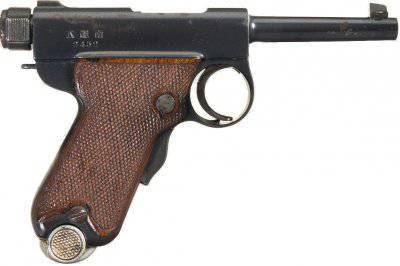 Despite the fact that the weapon was not accepted for service, production under it was already established, apparently in a hurry and did not wait for the test results. So that all this was not in vain, since the delivery of these pistols to China did not go far, they quickly figured out what was happening, it was decided to create a pocket version of weapons for civilian self-defense on the basis of a Nambu gun. The gap between word and deed was a short one; in a year, small pistols were actively stamped, still with their silhouette resembling Parabellum, but having nothing to do with it. In general, there was not much in common with the original weapon, not counting individual parts. The new pistol was called the Nambu B, better known as the Nambu Baby, respectively, after that the first version of the pistol was called the “father”. This weapon was supposed to be one of the most common means of self-defense, nevertheless greed destroys not only fraer, but samurai as well. The cost of this gun was 180 yen, while the price of the Colt M1911 for a more powerful and effective cartridge on the market was only 100 yen. To make it clear what the sums can be cited as an example, the amount that the lieutenant received per month, and it was equal to the entire 72 yen. In other words, the weapon should have been for such prices, if not gold, then, at least, the most effective, which it naturally was not. Let's try to figure out what kind of device it was and what real advantages and disadvantages it had, that its cost was almost twice as high as the Colt М1911.
Despite the fact that the weapon was not accepted for service, production under it was already established, apparently in a hurry and did not wait for the test results. So that all this was not in vain, since the delivery of these pistols to China did not go far, they quickly figured out what was happening, it was decided to create a pocket version of weapons for civilian self-defense on the basis of a Nambu gun. The gap between word and deed was a short one; in a year, small pistols were actively stamped, still with their silhouette resembling Parabellum, but having nothing to do with it. In general, there was not much in common with the original weapon, not counting individual parts. The new pistol was called the Nambu B, better known as the Nambu Baby, respectively, after that the first version of the pistol was called the “father”. This weapon was supposed to be one of the most common means of self-defense, nevertheless greed destroys not only fraer, but samurai as well. The cost of this gun was 180 yen, while the price of the Colt M1911 for a more powerful and effective cartridge on the market was only 100 yen. To make it clear what the sums can be cited as an example, the amount that the lieutenant received per month, and it was equal to the entire 72 yen. In other words, the weapon should have been for such prices, if not gold, then, at least, the most effective, which it naturally was not. Let's try to figure out what kind of device it was and what real advantages and disadvantages it had, that its cost was almost twice as high as the Colt М1911.The main advantage of the weapon was its weight and dimensions. The weight of the gun without cartridges was equal to all 580 grams, while its length was equal to 17 centimeters, the barrel was about 6-7 centimeters long. But the main drawback of the gun was his cartridge. It was a specially designed ammunition caliber 7 millimeters and sleeve length 20 millimeters. The bullet weight of this cartridge was equal to 3,65 grams, while its speed of movement was 280 meters per second. That is, the kinetic energy of the bullet was somewhere around 140 Joule. At that time, this cartridge was quite good for self-defense, because in Europe at that time ridiculous cartridges and pistols were used, however, if you look at this ammunition from the height of modernity, it is clearly not enough to stop the enemy.
From its progenitor (Nambu A), its reduced version received a maximum of details, which even if they did not fit into the compact dimensions of the weapon, were simply cut off to the desired length. So the pistol received exactly the same frame in which only the length of the handle was reduced, as well as the receiver in which the shorter barrel of the weapon was rigidly fixed. The shutter of the gun was left unchanged. Inside, the weapons were waiting for larger changes.
Automatic weapons built on the principle of working with a free gate, which is not surprising given the relatively weak cartridge, it is unclear why only the same automation system was not used in the previous model, with a reasonable approach, it would have coped with the cartridge 8х22. Despite the fact that the frame of the weapon and the receiver were still made in separate parts, now the receiver with the barrel was rigidly attached to the frame and could not move. Accordingly, the recoil spring of the receiver and the locking latch were removed from the weapon. The shutter still moved in the receiver, compressing the two return springs located on both sides. In general, the weapon was greatly simplified, and all the work on creation consisted in installing a shorter barrel, shortening the pistol grip and throwing out the unnecessary parts. In general, how not to count, and the gun is clearly not pulled at its cost, so it is not surprising that the weapon, which was predicted of high popularity, turned out to be unclaimed in the market. Is that the true patriots, who allowed the financial condition, acquired this sample in use. By the way, the interesting fact was that outside the country this gun was sold many times cheaper.
The fate of the Nambu, despite his failures with short-barreled weapons, was very successful. After the death of Arisaka, Nambu took his place, but he did not return to his pistols for a very long time. Nevertheless, the talent, and he obviously was a man, was not lost in vain. In 1914, the Type 3 machine gun was designed by him, and in 1922, the Type 11 light machine gun. All this time, the needs of the army for pistols were met by foreign purchases of short-barreled weapons, while the models were quite variegated, including the ammunition used, that is, in this regard, there was real chaos. In addition to overseas purchases, the same “solid soldier of tin” Type 26, which was to be replaced by Nambu A, was still in service with the army, but it did not. Anyway, the problem had to be solved, and there were two solutions, either to streamline the purchase of foreign pistols, or to create their own weapons. It is not difficult to guess which of these two options was chosen.
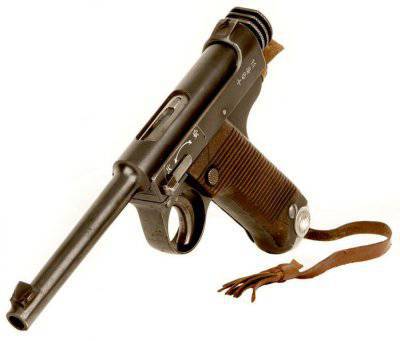 Being based on the same Nambu A, Kijiro began a profound modernization of weapons, or rather, to correct the shortcomings that were discovered during the testing of the pistol, just remember that the equipment did not stand still at that time. Kijiro was already not just a young designer, but an experienced gunsmith, who had seen many foreign models of the most diverse weapons and understood that the army was first of all waiting for a new pistol. The answer to the question why Kijiro did not choose a different, more modern weapon design, is not that the person wanted to advance his own pistol, with a memorable appearance and original work pattern of the automation. And the fact that the constructor already had weapons skills and to start everything again meant to lose time, and no one knows what the final result would be, at that time with Nambu. Everything was clear and all the nuances were clear.
Being based on the same Nambu A, Kijiro began a profound modernization of weapons, or rather, to correct the shortcomings that were discovered during the testing of the pistol, just remember that the equipment did not stand still at that time. Kijiro was already not just a young designer, but an experienced gunsmith, who had seen many foreign models of the most diverse weapons and understood that the army was first of all waiting for a new pistol. The answer to the question why Kijiro did not choose a different, more modern weapon design, is not that the person wanted to advance his own pistol, with a memorable appearance and original work pattern of the automation. And the fact that the constructor already had weapons skills and to start everything again meant to lose time, and no one knows what the final result would be, at that time with Nambu. Everything was clear and all the nuances were clear.Unfortunately, the production of Nambu B by the time it was long ago collapsed, according to the production base for the creation of a new gun in the old packaging was not. For this reason, the designer decided to change the appearance of his weapon. So immediately striking is the fact that the angle of inclination of the pistol grip was changed, as well as the fact that the frame of the weapon began to embrace the movable receiver in which the barrel of the gun was tightly welded and inside which the bolt of the weapon was moving. The back of the bolt was also changed, now it was not just a screwed knurled nut, but several washers with gaskets, which made retention of the bolt more reliable during recharging. The barrel of the weapon increased in length and became equal to 121 millimeters, while the dimensions of the weapon themselves increased. So the gun has become the length of 229 millimeters, with a height of 153 millimeter, its weight was 960 grams. Of the external differences, it should be noted separately that the gun got rid of the automatic fuse, but received an automatic, which was a fairly large lever, rotating 180 degrees and blocking the drummer. Sights also changed, or rather, changed the pillar, which became unregulated and was carried out as part of the weapon frame. Subsequently, with the start of production, the gun waited for other cosmetic changes, but about them a little lower.
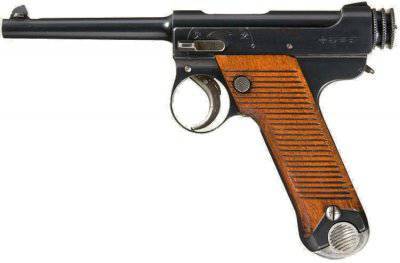 The first ready-made version of the gun appeared in 1925 year, a year later, this weapon entered service with the Japanese army, where it lasted until the 1945 year. Despite the success of the weapon, I would not call it natural, since it clearly could not have done without affecting the advancement of the pistol of the high post of its designer. More precisely, the pistol itself was excellent, the extended moment of recoil, very high accuracy for such a weapon and comfortable holding in hand were beyond praise. But the gun ammunition failed. The fact is that the same relatively weak cartridge 8х22 was used in the pistol and if at the time of creating the weapon this cartridge could still be called suitable for the army, then during World War II it turned out that the effectiveness of the ammunition was clearly insufficient. However, it is already the fault of very different people that the weapon was not modernized and the ammunition was not replaced, however, Kijiro could look into the future by creating a cartridge at least close to 9х19 for his weapon, because no one insisted on creating a sample of the one that feeds. 8x22 chuck. At least it was possible to recycle bullet cartridge.
The first ready-made version of the gun appeared in 1925 year, a year later, this weapon entered service with the Japanese army, where it lasted until the 1945 year. Despite the success of the weapon, I would not call it natural, since it clearly could not have done without affecting the advancement of the pistol of the high post of its designer. More precisely, the pistol itself was excellent, the extended moment of recoil, very high accuracy for such a weapon and comfortable holding in hand were beyond praise. But the gun ammunition failed. The fact is that the same relatively weak cartridge 8х22 was used in the pistol and if at the time of creating the weapon this cartridge could still be called suitable for the army, then during World War II it turned out that the effectiveness of the ammunition was clearly insufficient. However, it is already the fault of very different people that the weapon was not modernized and the ammunition was not replaced, however, Kijiro could look into the future by creating a cartridge at least close to 9х19 for his weapon, because no one insisted on creating a sample of the one that feeds. 8x22 chuck. At least it was possible to recycle bullet cartridge.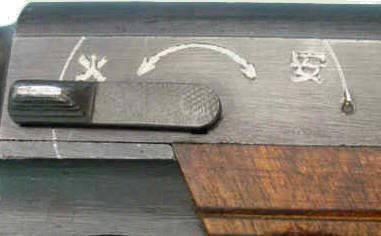 Automatic pistol remained completely original, inherited from the Nambu A, but now the coupling of the bolt with the receiver was due to the spring-loaded parts, which ensured trouble-free operation of automation in any conditions and under any external influences. The weapon really turned out to be very good, the only disadvantage is the difficulty of servicing the gun, as well as too expensive production, which for those times was quite difficult. But the winners are not judged, and this pistol has established itself as an excellent weapon, albeit using a low-power cartridge.
Automatic pistol remained completely original, inherited from the Nambu A, but now the coupling of the bolt with the receiver was due to the spring-loaded parts, which ensured trouble-free operation of automation in any conditions and under any external influences. The weapon really turned out to be very good, the only disadvantage is the difficulty of servicing the gun, as well as too expensive production, which for those times was quite difficult. But the winners are not judged, and this pistol has established itself as an excellent weapon, albeit using a low-power cartridge.Subsequently, the pistol received various changes, but they did not deal specifically with the design of the weapon and its automation, and consisted mainly in improving the ergonomics of the weapon and its appearance. So the gun first lost the fuse switch, and then this element was returned to its place, the shape of the safety bracket changed, the handles on the handles changed, the nut on the back of the bolt and the gun cover, but all this did not make the weapon radically different, as if was the replacement of ammunition.
Now the Nambu pistol is little known, and if they know about it, it is only by its latest version, and then because of the participation of these weapons in the Second World War. Nevertheless, such a weapon was, although it was not widespread, but its mark on stories it left, so be aware of its existence is necessary.
Source http://www.opoccuu.com
- Karasik Kirill
- www.opoccuu.com
Information